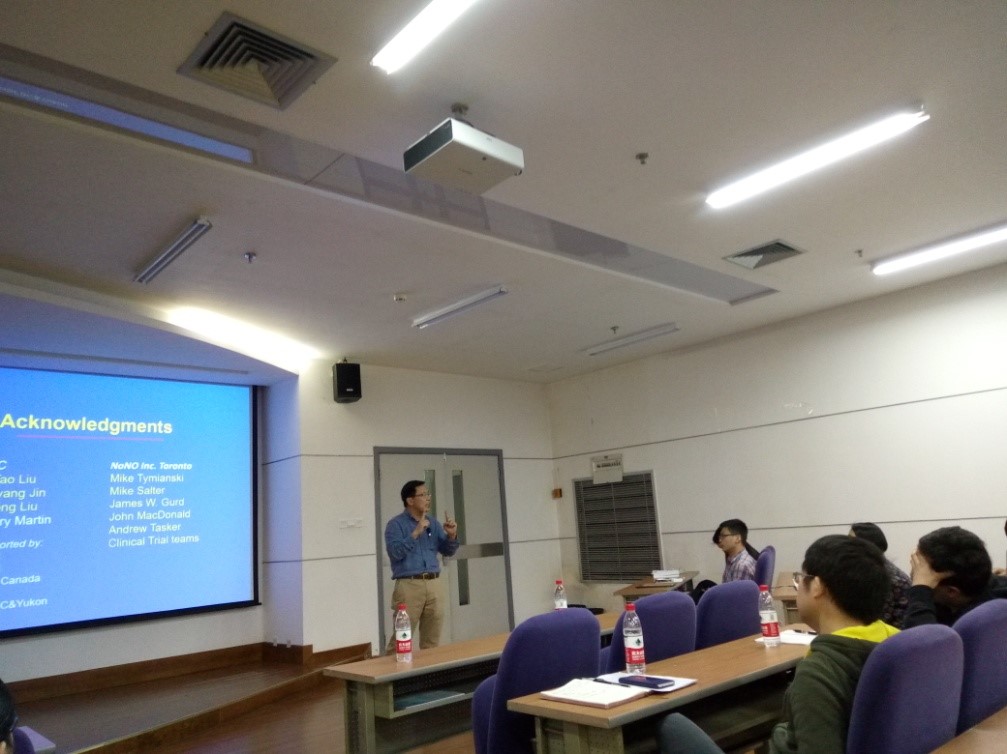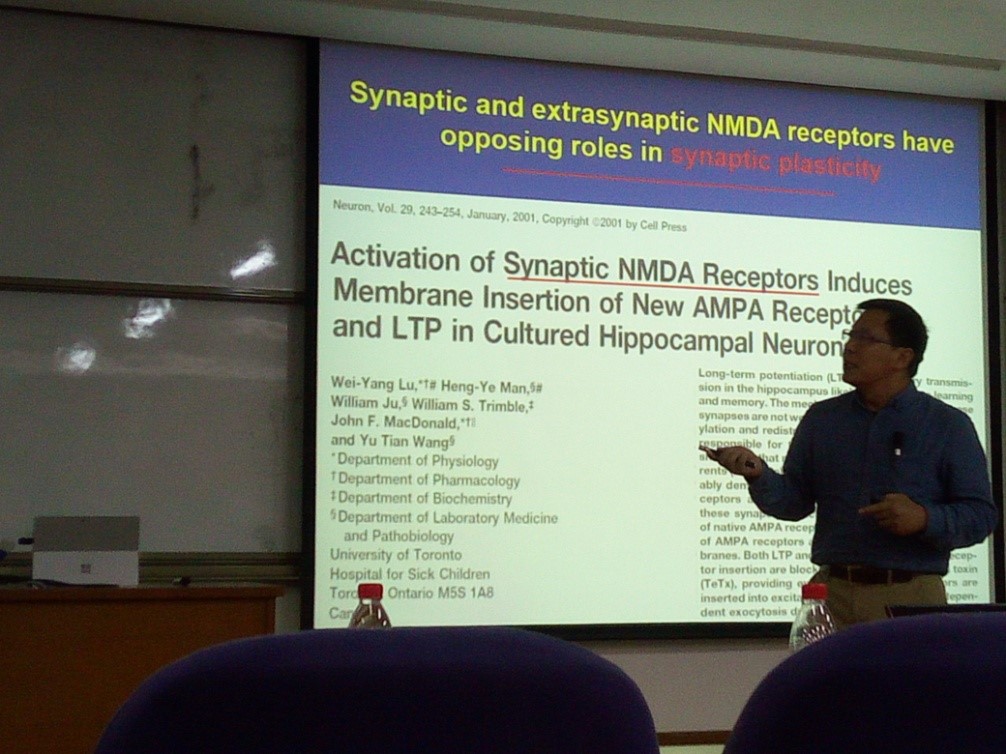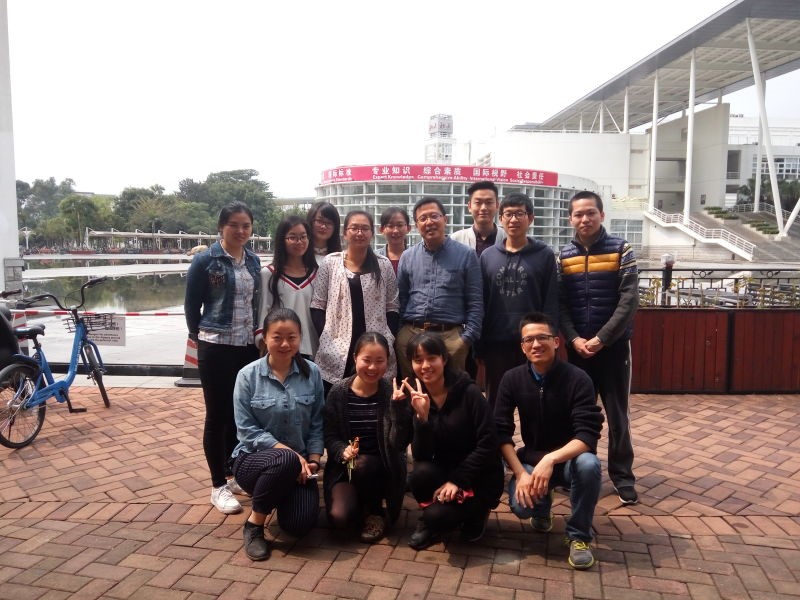On March 6, 2017,professor Qiang Zhou and Shupeng Li invited professor Yu Tian Wang who is from University of British Columbia to visit our school, In the morning hours the day, professor Wang gave his report named“Bench to Bed Translational Medicine Research—Can we cross the Death of Valley? ”to us. He combined with the research works of their own to show us how research results transfer from bench to bed, and the questions and difficulties existing in this process. In the meantime, he also talked about some interesting research works they had done, all the teachers and students were attracted by professor Wang’s topic, and they raised a lot of questions at the same time. In a word, this seminar enhanced our mutual understanding and friendship via ardent communication with professor Wang.

At the beginning of this seminar, professor Wang told us the whole story about NA-1 from discovering to the phase III clinical trials. Taking this opportunity, he introduced the concept of translational medicine to us, and he also told us how fundamental researches enter clinic treatments, of course, the questions and difficulties existing in this process. In this part, he emphasized the findings of NA-1, NA-1 is a peptide (Tat-NR2B9c). Stroke is induced by cerebral hemorrhage or cerebral anoxia, both cerebral hemorrhage or cerebral anoxia can cause cell death. So, how did professor Wang and his team found this drug? As we know, glutamate is a primary excitatory neurotransmitter and responsible for mediating a broad range of nervous system functions through glutamate receptors(NMDAR), there are three functional native NMDARs, includingNR1/2A、NR1/2B and NR1/2A/2B. NR1、 NR2A and NR2B are three type of subunits composing NMDARs. NR2 subunits may differential functions—NR2A and NR2B-containing receptors have opposing roles in synaptic plasticity and cell fates(survival VS death). NR2A locates in the synapse, while NR2B locates in the extrasynapse. Under Normal Circumstances, glutamate will interact with NMDAR in the synapse, and mediate the normal functions of neurons, but during a stroke, when blood and oxygen to the brain are restricted, glial cells lose the function taking up the glutamate in the synapses, so brain cells release glutamate into the space surrounding them, glutamate will interact with NMDARs containing NR2B,PSD95 interacts with both NR2B and nNO, thereby coupling nNO to NR2B,mediating NMDAR-mediated cell death. So according to the sequence of NR2B, professor Wang and his team designed a peptide named Tat-NR2B9c, Tat-NR2B9c interferes the interactions between NR2B and PSD95, thereby disrupting the NR2B-nNOS coupling and preventing NO-mediated neuronal death. According to the properties of Tat-NR2B9c, professor Wang’s team set up a company themselves to design clinical trials. NA-1 had already finished phase I and phase II clinical trials, and they had proved that NA-1 is effective as a stroke treatment.

Besides that, professor Wang also introduced the peptide-based knock-down technology, which facilitates translational medicine research. Inspired by NA-1, professor Wang and his team designed a interference peptide, this peptide could bind α-synuclein and mediate its degradation, thus relieved symptoms of Parkinson's disease.
Finally, professor Wang continued communicating with students at a luncheon, the conversation involved many aspects from study to life, all students had a lovely afternoon.(Written by Xiaoli Gao)

Brief introduction of speakers:
Professor Yu Tian Wang, Professor and Fellow of the Academy of Science of the Royal Society of Canada, Department of Medicine and Brain Research Center, University of British Columbia, Canada. He graduated from Shangdong University Medical School, Jinan,P.R. China in 1982, and then he got master degree in 1985 at the same school. In 1992, he was studying for a doctor's degree at the Memorial University of Newfoundland, Canada.
honors:
2014 国务院侨办海外专家咨询委员会委员
2006 Fellow of the Royal Society of Canada (the Academy of Sciences of Canada)
2001-2011 Howard Hughes Medical Institute International Scholar
2005 Killam Professor, UBC
2004 The J.A.F. Stevenson Lecturer of the Canadian Physiological Society
2002 UBC Distinguished University Scholar
2002-2007 Michael Smith Foundation for Health Research Senior Scholar
2001-2006 Canadian Institutes of Health Research Investigator
2002 中国科学院海外评审专家
2002 中国自然科学基金海外评审专家
2007 长江教授海外评审专家